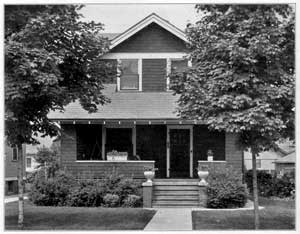Small Home Gazette, Summer 2008
The Greenest House
The greenest house is the house already built. But that doesn’t mean you shouldn’t make your old house even more ecofriendly. Here are 10 tips to green your home while maintaining its historic integrity.
 1. Keep original windows intact. Studies show that older windows can perform as well as vinyl replacements. Weatherstrip them so that they seal tightly, caulk the exterior trim, and repair cracked glazing or putty around glass panels. You’ll reduce landfill waste and the demand for vinyl, a nonbiodegradable material that gives off toxic byproducts when it’s made.
1. Keep original windows intact. Studies show that older windows can perform as well as vinyl replacements. Weatherstrip them so that they seal tightly, caulk the exterior trim, and repair cracked glazing or putty around glass panels. You’ll reduce landfill waste and the demand for vinyl, a nonbiodegradable material that gives off toxic byproducts when it’s made.
2. Use light paint colors for your house’s exterior. Lighter colors reflect heat better than darker ones.
3. Insulate the attic, basement and crawl space. About 20 percent of energy costs come from heat loss in those areas.
4. Reuse old materials such as brick, stone, glass and slate when making home improvements. If you’re rebuilding a staircase, for example, use wood from the summer kitchen or shed that couldn’t be saved.
5. Install fireplace draft stoppers, attic door covers and dryer vent seals that open only when your dryer is in use. An open dampener in a fireplace can increase energy costs by 30 percent, and attic doors and dryer vent ducts are notorious energy sieves.
6. Plant trees. Evergreen trees on the north and west sides of your house can block winter winds, and leafy trees on the south and west provide shade from the summer sun. Using old photos of your house, try to match the historic landscaping.
7. Have an energy audit done by your local utility company or visit Home Energy Saver (http://hes.lbl.gov) Audits can help pinpoint problem areas and measure energy savings after you improve your home’s efficiency.
8. In summer, open the windows and use fans and dehumidifiers, which consume less energy than air conditioning. Many old houses were designed with good cross-ventilation; take advantage of your home’s layout.
9. Keep doors airtight by weatherstripping, caulking and painting them regularly Recent studies suggest that installing a storm door is not necessarily cost-effective.
10. Restore porches and awnings. Porches, awnings, and shutters were intended for shade and insulation. To save energy, draw shades on winter nights and summer days.











